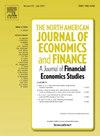Investment opportunity strategy in a double-mean-reverting 4/2 stochastic volatility environment
IF 3.8
3区 经济学
Q1 BUSINESS, FINANCE
North American Journal of Economics and Finance
Pub Date : 2025-01-01
DOI:10.1016/j.najef.2024.102358
引用次数: 0
Abstract
The investment-timing problem and the valuation of the right to take certain business initiatives in a given project (called a “real option”) have been considered by many authors under the assumption that volatility of the present value of the expected future net cash flows is stochastic. In this paper, we re-tackle these problems by assuming that the present value of the expected future net cash flows follows the double-mean-reverting 4/2 stochastic volatility model, proposed recently by Cao et al. (2023). Applying an asymptotic analysis approach outlined by Fouque et al. (2011), we obtain two approximation formulas for the value of the real option and the investment threshold, respectively. We conduct numerical experiments on sensitivity analysis of the formulas with respect to the model parameters (“Heston”- and “3/2”-factors) and the associated variables. Furthermore, we also conduct the least square Monte Carlo (LSM) simulation proposed by Longstaff and Schwartz (2001), and compare the real option values from our approximation formula with those from the LSM simulation. Our analysis shows that the relative errors are less than 0.3% in most of our cases, which justifies the appropriateness of our asymptotic approach for the model.
双均值回归4/2随机波动环境下的投资机会策略
在预期未来净现金流的现值波动是随机的假设下,许多作者已经考虑了投资时机问题和在给定项目中采取某些商业举措的权利的估值(称为“实物期权”)。在本文中,我们通过假设预期未来净现金流的现值遵循双均值回归4/2随机波动率模型来重新解决这些问题,该模型最近由Cao等人(2023)提出。运用Fouque et al.(2011)提出的渐近分析方法,我们分别得到了实物期权和投资阈值的两个近似公式。我们针对模型参数(“Heston”-和“3/2”-因子)和相关变量对公式进行了敏感性分析的数值实验。此外,我们还进行了Longstaff和Schwartz(2001)提出的最小二乘蒙特卡罗(LSM)模拟,并将我们的近似公式与LSM模拟的实物期权值进行了比较。我们的分析表明,在大多数情况下,相对误差小于0.3%,这证明了我们的渐近方法对模型的适用性。
本文章由计算机程序翻译,如有差异,请以英文原文为准。
求助全文
约1分钟内获得全文
求助全文
来源期刊
CiteScore
7.30
自引率
8.30%
发文量
168
期刊介绍:
The focus of the North-American Journal of Economics and Finance is on the economics of integration of goods, services, financial markets, at both regional and global levels with the role of economic policy in that process playing an important role. Both theoretical and empirical papers are welcome. Empirical and policy-related papers that rely on data and the experiences of countries outside North America are also welcome. Papers should offer concrete lessons about the ongoing process of globalization, or policy implications about how governments, domestic or international institutions, can improve the coordination of their activities. Empirical analysis should be capable of replication. Authors of accepted papers will be encouraged to supply data and computer programs.

 求助内容:
求助内容: 应助结果提醒方式:
应助结果提醒方式:


